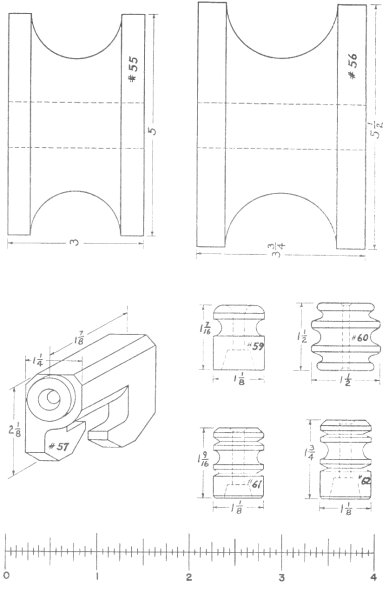Standard Porcelain
by Jack H. Tod
Reprinted from "INSULATORS - Crown Jewels of the Wire", April 1973, page 25
In 1881 Thomas Edison invented the incandescent lamp, and in 1882 he
installed a 1200-horsepower generator in a New York warehouse and began
furnishing power (at 1300 volts DC to "subscribers" for operation of
electric lights.
Electric street lights were first installed in Syracuse, New York in 1882,
and in 1883 a New York grocer became the first person to use transmitted
electric power for a purpose other than lighting when he hooked an electric
motor to Edison's line and connected it to his coffee grinder. The first
electric railway came into use in 1885 when Richmond, Virginia converted 12
horse-drawn trolley cars to electric drive.
It was at about this time that R. Thomas & Sons, and possibly other
porcelain companies, started making "electrical porcelain" insulators
to facilitate the distribution of electricity from the generating stations to
subscribers. The electrical industry grew at an explosive rate during these
early years, and the numerous porcelain manufacturers of the period created a
large variety of insulators. The patents issued in the 1890-1900 period showed
that everybody thought he had an insulator knob or cleat which would be the
winning ticket.
Not only was there a general state of confusion in the types of wiring
insulators in use and the methods in which installations were made, but serious
electric shocks and fires were very prevalent. In an effort to end the chaos,
the National Board of Fire Underwriters founded the Underwriters' Laboratories,
Inc. in 1894 to formulate safety standards for the industry.
The National Electrical Code was first published in 1897 as the result of a
national conference of engineering and underwriters' organizations, and was
revised every two years by the Electrical Committee of the National
Underwriters' Electrical Association. One major section of the Code deals with
the materials, fittings and method of construction, and our interest here is
with the standards for the porcelain insulators - knobs, cleats, tubes, etc.
We are picturing in this article the "standard porcelain' knobs of the
Code, and I've made these drawings especially for this issue. The drawings are
1/2 size and the measuring scales full size if our printing work turns out okay.
There was one major revision of the knobs in the Code in the 1930's -
deleting some items, adding others and changing the dimensions of some knobs.
The sizes shown are generally the New Code (N.C.) ones, but both sizes are shown
for the #5 1/2. I have never seen very early copies of the Code and have no idea
of what the missing number knobs might have been, or even if they ever existed
at all.
This chart is nominally that for solid knobs, but the split ones normally
used an forestry insulators are shown. These are the Victor #22, the #37-Split
and the #38-Split. The ultracommon #5 1/2-Split is the proverbial "nail
knob" and will be the subject of a separate article in a later issue. There
were many more #5 1/2-Split knobs made than all the other knob shapes combined!
Manufacturers followed the Code in the more important and specified features only, such as hole diameter, groove size, etc. They
generally took off on their own with regard to unimportant details, such as
crown curvature, beveled corners, base counterbore shape, etc. There is also
some discrepancy between manufacturers on outline dimensions and on method of
numbering. For instance, some companies list the #3 1/2 in this chart as a #3
W.G. (wide groove).
As you can see, there was a standard knob for virtually every use. Nearly all
these shapes are common and can be found in the junk bins of secondhand stores
and electrical wiring companies. Some junk yards and salvage companies have
mixtures of this literally by the barrels.
Collecting standard porcelain "general" (every shape with every
marking) is practically hopeless; you need just about everything you see! A
representative collection can be had by collecting (a) one of every shape
without regard to marking and (b) one of every marking without regard to shape.
If this seems too confining, there are two good offshoot collections you can
build. Try to get every possible shape from one company such as Brunt, Findlay,
Knox, etc. Or pick a couple of pet shapes such as the #1 or the Victor #22 and
go after all the different markings on them.
Collecting "standard porcelain" is a real fun hobby for those who
enjoy the chase of collecting for itself. This is where we part company with the
big money boys and the antique store circuit. We do our collecting at old
abandoned houses, at flea markets, at junk yards , etc. The going price at flea
markets is a nickel apiece (or less) for the smaller items and maybe even a
whole two bits for a bigger goody. It once took me 3 full days to go through 4
barrels of this in the back yard of a secondhand store, and I bought the 75
pounds or so of goodies I picked out for a $5 bill.
In general we swap "standard porcelain" very casually. more or less
on the basis of "this here pile of mine for that there pile of yours".
But we do have some shapes and markings we don't trade away too freely, and we
have some items that we are outright chasing too. I know if I ever got all
standard chart shapes except for the last one, my wallet would probably start to
speak louder and louder.
For your convenience we have placed this chart where you can lift the staples
and remove it from the magazine for handy use in collecting these
"fun" insulators. Good luck, and see y'all at the flea market Sunday.
Jack





| 